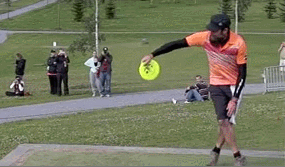This is probably going to come off pretty harsh (I hope it doesn't), but in the interest of helping people learn, i'm going to stick my neck out. It's confusing as heck trying to interpret the writings of the three B's (blake/brad/beto), or even DD when you're learning. So in the interest of keeping the confusion to a minimum:
Both are rail methods, though. Every throw is on a rail. The "rail method" is just maximizing the exploitation of the backwards-R lever.
Hammer pound is also there in all methods. It's maximizing the exploitation of the lever length of the disc, and somewhat acceleration in general.
The rail method is called the "rail" because it FEELS like your hand/disc is on a roller coaster. It feels like it's going around a corner at 89789345 mph and there's 9 ton's of g-forces on the disc as you go around the rail. When you first find the rail, you should also mentally be experiencing similar emotions/thoughts as if you were actually on a roller coaster. eg: OOOOOHHHHHHH SHHHiiiiiiiiiiiTTTT WHAAAT DOOOO iiiiiiiiiiiiiii DOOOOOOOOOO WiiiiiiiiiiiiiiiiiiiiiiiiiTH THiiiiiiiiiiiiiiiSSSSSS DiiiiiiiiiiiiiiiiiiiiSSSSSSSSCCCCCC (as you're going around the rail).
The hammer pound method, is called that because it FEELS like you're pounding a hammer. You cannot start off the throw (read as: start from the right-pec position) using the rail, and then switch to the hammer pound at the end -- it just doesn't work like that.
you cannot mix and match the "rail" and "hammer pound" techniques. The rail is a very fluid motion, it doesn't load up your wrist, or rely on your wrist at all really. The hammer pound is not fluid (compared to the rail at least, on video it all looks very fluid), you have to accelerate your arm/hand into a pre-defined point to have all the levers unload. The hammer-pound is used for a powerful forehand, OR backhand, throw.
In a forehand hammer pound: you glide into your pre-defined point, and then pound the **** out of it to slam your wrist CLOSED (into a locked closed position). Your wrist and fingers leverage the disc while they are closing. You could glide in, and keep gliding all the way through, or even accelerating, all the way through, but without the predefined point, the levers wont unload the way you need them to.
The backhand hammer pound is practically identical, except your wrist isn't as strong in opening as it is at closing. Smooth, glide into the predefined point, and then pound the crap out of it to slam your wrist OPEN (into a locked open position). The wrist and fingers, again, leverage the disc as they are flying open. You can't throw as far with this, because your wrist is much stronger in closing than in opening, however, the backhand hammer pound has a trick up its sleeve! From this slammed-open wrist-locked forward position, you're in the perfect position to rotate your torso/shoulders and accelerate the disc to never-before-achieved speeds, while it is pivoting and trying to fly forward -- something that you can't do throwing forehand.
The RAIL is a concept that came up on DGR, which was a description for the path of the hand moving through the back swing and through the follow through. There were 2 main ideas with the rail:
1. The Normal back swing, elbow extension and hit - that allows the disc to be pulled along a straight line into the right pec and extended along that line into the hit.
2. The wide rail, is something that is most commonly seen with Nate Doss.
The back swing is more like leaving the disc away from you than behind you, and the shape of the extension is changed. The acceleration happens later and through some wizardry - it's much easier to hold the disc later into the hit.
IMO, the rail has nothing to do with whether you have a wide reach-back or not. Maybe you were already saying that?
I wrote a long article about it
here. But the idea is that the hit happens when you pull around the front of the disc and hold the rim until the disc ejects forward. By then pulling back on the rim, the disc ejects so that it can leave your hand faster than your hand was actually travelling.
What you are describing, to me, sounds like a half-hit. If your shoulders are pulling your hand around the disc, there's no way for your wrist to fully unload.
Anyways, again, i apologize if this is coming off harsh. I'm just trying to save years of trial and error for people that ever decide to go down the big snap road.

